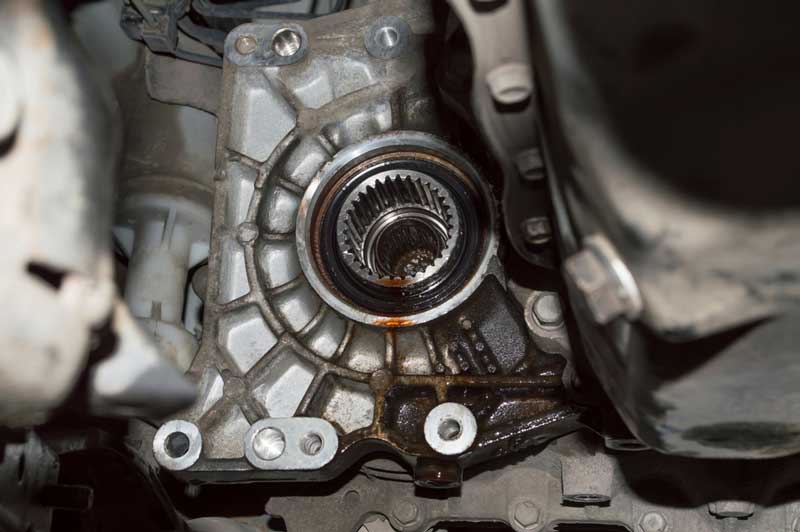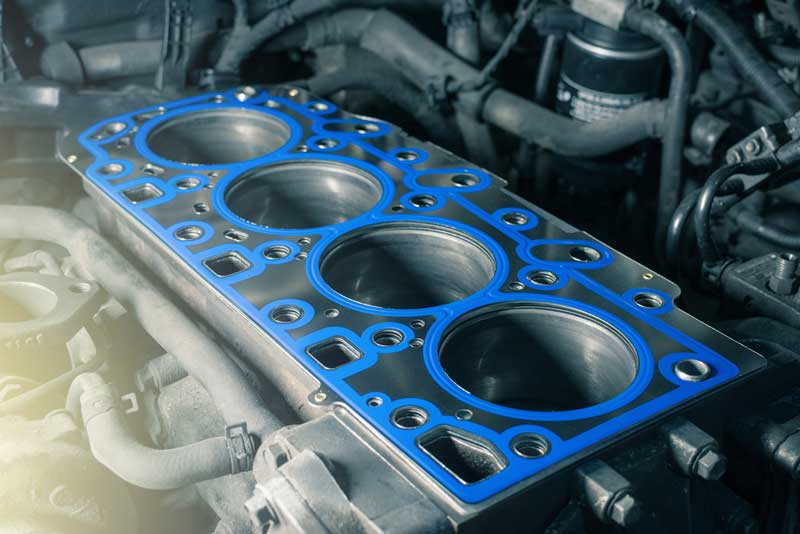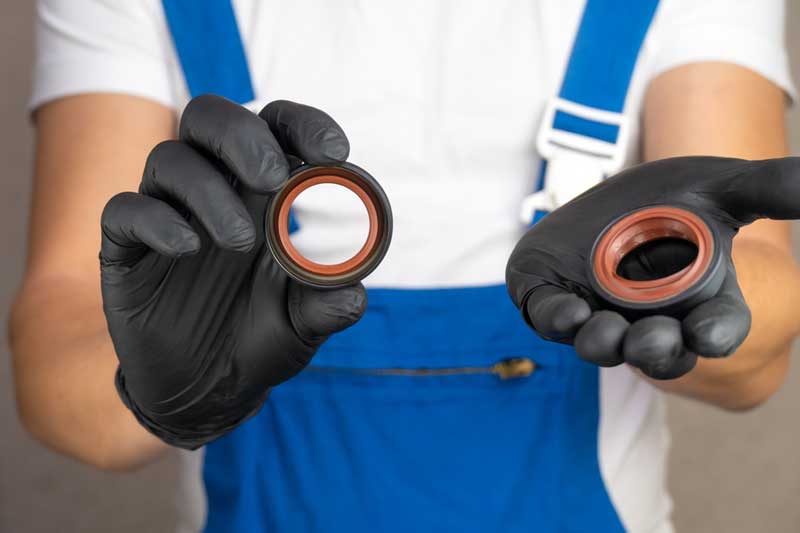What causes transfer case leaks? How do I know if I have a leaking transfer case?
A vehicle’s transfer case helps distribute the power from the engine to all the wheels using components like the rear and front axles. The transfer cases are found in cars marked all-wheel drive (AWD) in each reel.
In every car, the engine Powers the transmission system, which talks to every wheel through the vehicle’s transfer case. Case power is sent to the transfer’s output shaft, drive chains, hydraulics, and gear mechanisms.
This article dwells on factors that might cause transfer case leaks and hacks and fixes for these problems. Here, you would also learn about symptoms and signs for troubleshooting leakages from the transfer case.
Let’s get started!
Introduction to Transfer Case And Its Working Principles
The gearbox in a four-wheel drive vehicle can be referred to as a transfer case. This gearbox is usually connected to the backside of the engine of four-wheel drive cars. This transfer case helps transfer power from the car’s engine to every vehicle wheel instead of just the front or back wheels, depending on where the machine is located.

A set of two different gear setups are the components of the transfer case. One of the two-gear setups is connected to the axles, while the other is connected to the engine.
The first-gear setup turns at speed different from the second-gear configuration. Because of the different rates in the two gear sets, more power is generated before it is transferred to turn the car’s wheels. The total amount of traction needed at a specific wheel determines how much power is sent to that will; therefore, the force sent to every car wheel continuously varies. An example is when a particular choice starts slipping, more power will be needed in the three other wheels to pull on the slipping wheel to move the car forward.
With a transfer case feature, you can shift or four-wheel drive call, which runs on two wheels to use its wheels. This maneuver can be done by disengaging or engaging the front axle of the car. Engaging the axle at the show who wrote sends power to all the wheels in the vehicle, while disengaging the front axle means more/all power is distributed to the wheels at the rear.
In modern vehicles, transfer cases a fully automatic. However, previous models from some years back might still need a driver to manually engage or disengage the rear or front axle concerning the driving situation.
What Causes Transfer Case Leaks?
Usually, a failure in the gasket or seal is what results in a leak in the transfer case. The gasket is a rubber piece that separates the two halves of the transfer case. This is to prevent liquids from leaking out. When the seal is replaced, the problem can be easily fixed.
Many factors cause leaks in transfer cases, and every leak might need a different approach and tools to find a solution. Finding the origin of a leakage in the transfer case is not tedious; however, fixing these leakages might require a complex answer. Listed below are some of the major causes of leaks in the transfer case, and they include;
1. Irregularities in the U-Joint
The u-joint is integral to every very close drivetrain as they help prevent binding. The u-joints are also mechanical components and susceptible to wear and tear. The deterioration of the u-joints leads to excessive vibrations, which can cause differential leakages and transfer case leakages.
The continuous vibration would cause the input and output shaft seals to lose integrity and break and release fluids. Replacing the u-joint and every other damaged part is the only way to fix this problem. Make sure the shaft seals are also replaced
2. Loose Plugs
Usually, vehicles are designed to possess a fill and drain plug. On the top of the transfer case, you can locate the fill plug just above the central line of the transfer case housing. However, if you are looking for the drain plug, you can identify it the beneath the transfer case housing.
Fluids from the transfer case can escape whenever the drain or fill plug has been compromised. Nevertheless, both plugs can cause massive leakage even though they seem sealed off.
3. A Leaking Output Shaft Shield
Transfer cases are designed with their output shaft having seals and special couplings that ensure fluid stays in the output shaft, preventing leakages. Nevertheless, as time passes, DC on the output shaft starts to dry, making it brittle. Once the seals have lost all elasticity, the break and fluid start passing through the seals. This leakage will start small but increase over time and become problematic as the seal’s condition worsens. This leakage is characterized by oil pouring out of the output shaft, and if you observe closely, you will see that the leaking seal will be drenched in oil.
4. Bearings are Wornout
Bearings and mechanical components can be subjected to wear and tear over a long period. This progressive bearing wearing can lead to oil leakages from the crankcase. This kind of leakage is usually seen in transfer cases that have been used for a long time without proper maintenance or replacement. The origin point of this leakage is generally at the output or input shaft bearings. Do you know that today high distance traveled by car, the seal preventing oil leakage is who will be damaged extensively, leading to a large amount of oil leakage?
Whenever you notice a leakage and the damaged seal is replaced with a new one, but after some time, the returned sale starts leaking from the same place, then there is a high probability that you are facing a one internal bearing
5. Damage to the Housing Gasket Of Your Engine
To properly disassemble a transfer case, a decentralized seam should be located. Then you can begin disassembly. A centralized seam is situated at the most comprehensive parts of the transfer case housing, usually closer to the rear of the engine.
Disassembling the transfer case is is mostly done to inspect the transfer case housing, chain drive, gears, and other internal components. A unique housing gasket acts as a seal and a binder of both sections on the seam. Over time the gasket deteriorates and becomes weak and cannot effectively seal the housings together; therefore, fluid can leak out of the gasket, which joins the transfer case housing.
When this happens, it becomes crucial to replace the gaskets inside the cars transfer case by Simply disassembling the transfer case, taking out the Old gasket, and putting in a new one.
Also Read: Transmission Fluid Leak (Causes & Solution)
Can Transfer Case Leaks Damage a Car?
Leakages in the transfer case can cause many complications for any car. This conclusion is derived from the fact that the fields meant to lubricate and cool mechanical components within the crankcase will dwindle over time, causing wear and tear and increasing heat through friction. The transfer case will feel overtime as day gears continually grind each other and other components wear out.
In addition, wherever there is a leakage on the transfer case, they are simultaneously opening for specks of dirt, water, and unwanted debris to enter it. With these foreign particles within the transfer case system, the gears will have problems, costs, and complications for other components.
Whenever a leakage is noticed, irrespective of the size, it is advisable to repair it as soon as possible or visit a professional mechanic to replace the worn-out gasket and seals which caused the leakage.
When To Change your Transfer Case
Many signs can help you know when your transfer case needs to be replaced. The first sign(popular amongst drivers) is when your wheels start losing power. This power loss may be a result of gear or bearing issues.
Another vital sign is the observation of grinding sounds when switching from four-wheel drive to two-wheel drive or vice versa. The syndication shows that the gears have begun to deteriorate and must be replaced immediately.
Whenever any of these signs are noticed, it becomes paramount to get your transfer case checked out by a professional mechanic who can detect any fault and get it repaired immediately.

Preventing Transfer Case Leaks: Here is What to Do
Problems relating to fluid leakage from the transfer case can be strenuous; therefore, it is advisable to try and prevent these issues instead of looking for a solution after the leakage has already begun.
In this section, we will highlight some hacks and tips that could help in the preventive maintenance of your transfer case, which will help it remain sealed and prevent leaks.
Regular Maintainance
One vital thing that should be continuously done on your car is timely maintenance, and when you carry out this maintenance, make sure also to service the transfer case. Servicing the transfer case, in simple terms, means frequently changing the oil (fluid), which helps lubricate the gears in the transfer case. When changing the oil, be careful only to use the recommended oil by the manufacturer.
It is also wise to inspect your seal and gasket from time to time to make sure that there are no leakages on them. You could also watch your crankcase occasionally to ensure dirt and debris stick to the seals.
Reduce Driving on Bad Roads
In addition, to prevent frequent leakage from the transfer case, reduce driving on bad roads or muddy roads, and if your geographical location prevents you from keeping up with this condition, try going at low speeds when on bad roads. Employing the services of a professional technician is the best way to fix a transfer case leak. Also, when it comes to fixing leakages, ‘the earlier, the better’.
Its Important to Note:
Transfer case leak scan starts very small and progressively becomes very problematic. Nevertheless, transfer case leaks are a common issue, although it is easily prevented by timely and quality maintenance.
Following the tips highlighted above will keep your transfer case in proper working condition and avoid an excellent probability of leakage. However, neglecting a transfer case leak could lead to the total failure of the vehicle sooner than expected.
Fixing Transfer Case Leak
Whenever one faces leakages problems, it is always advisable to primarily identify the level of fluid that remains in the transfer case. If the fluid level has gone below a safe zone, it is paramount to top off the liquid above the secure area.
A fill plug can be found on the body of the transfer case either at the top or on the side, but sometimes it might be behind the transfer case. Once the fluid has been received into the transfer case, carefully watch for leakage. If there is any leakage, the solution is to replace the compromised seal.
Replacing the output seal in the front area
Step 1: Remove the drive shaft, then lose the plate which holds the seal in position.
Step 2: Replace the worn-out seal with a new one
Step 3: Apply sealant on the new seal installed
Replacing the output seal in the rear area
Step 1: Remove the drive shaft, then lose the transfer case and the back of the transmission
Step 2: Push the matter forward to gain access to the seal.
Step 3: Replace the worn-out seal with a new one
Step 4: Apply sealant on the new seal installed
If the issue occurs along the input shaft seal, disassemble the transfer case to gain easy access
Working on the input shaft seal can be tedious and confusing fixing issues on the output shaft seal. Therefore it is best to employ professional help when fixing input shaft seals.
Once you have successfully replaced the seals, it is wise to check the fluid level in the transfer case and pour in more fluid if needed. Confirm if there are no more leaks once you finish the process.
Also Read: Head Gasket Leak (Causes & Solutions)
Frequently Asked Questions – Transfer Case Leaks
Can one drive if the vehicle’s transfer case is broken?
Professionals highly discourage driving a vehicle with a damaged transfer case because doing this has severe mechanical implications; one may make the case to a point where it can’t be repaired anymore. It is also possible to damage the transmission, axles, and drive shafts while doing this.
What is the cost of fixing a leaking transfer case?
Replacing an output shaft seal ranges from $222 – $267.You might also spend within the range of $171 – $216 to employ professional labor. Buying the parts needed is relatively cheap as no major part got damaged. Purchasing parts should not cost more than $60.The prices will vary considering the car’s brand, model, and taxes.
What Happens when one abandons leakage problems?
If a driver neglects his transfer case linkage issue, there will be a decline in the performance of the transfer case, and before long, the transfer case will develop a wide range of problems that may be difficult to fix. The progressive destruction of the transfer case may also negatively affect the engine and transmission. Driving with a transfer case in improper working conditions isn’t easy.
How long can a transfer case seal last?
The life span of a transfer case seal depends on the usage of the vehicle. However, inspecting the seals, plugs, and gaskets every 30,000 miles for signs of weakness and deterioration is advisable. Meanwhile, change the fluid within the transfer case after your inspection. If this preventive action is not carried out, the 4WD feature on your car may fail due to a damaged seal.
What happens when a transfer case is short of oil?
A low level of fluid in the transfer case can be very problematic. The transmission function of changing gears will be hindered, and the gears could even get stuck sometimes. There is no way a driver will enjoy driving with these issues. The car will face challenges utilizing its 4WD feature. The transfer case could also cause irritating sounds, especially if the fluid is dirty.
The oil shortage also causes a reduction in lubrication, and components of the transfer case grind each other.
Can one drive with a case leak problem?
It is possible to drive with a leak problem. However, the loss of fluid through the seals on the transfer case reduces lubrication within the case. In other words, as the car is being driven, components within the transfer case begin to wear and grind against each other leading to overheating and, terminally, the total failure of the 4WD feature of the vehicle.
Why will a transfer case leak?
Leakage can occur in a transfer case because of many reasons. Transfer cases work with fluid within them. Therefore the transfer case needs to be serviced occasionally. But leakages can occur because of worn-out bearings, damaged seals, broken gaskets, or compromised plugs. Even the crankcase itself might have an internal problem with the shaft.
How long do transfer cases stay in good condition?
The lifespan of transfer cases varies from vehicle to vehicle; therefore, you cannot get a definite duration or distance traveled before a transfer case becomes faulty. However, there have been cases where transfer cases go bad after 6,000 miles, but many remain in proper working condition for as long as 300,000 miles. Maintenance plays a significant part in increasing the lifespan of your transfer case. Meanwhile, try getting a warranty after every care at the auto shop.
Can problems with the transfer case lead to transmission issues?
On numerous occasions, driving with a faulty transfer case has led to severe cases where other vehicle parts get damaged. A car’s transmission is usually the first component to become defective due to driving with a faulty transfer case. It is advisable to fix any issue immediately on the transfer case, as this preventive measure will reduce the risk of damage to other parts of the car
Conclusion – Transfer Case Leaks
Leakage found on a transfer case usually originates from a compromised seal, gasket, or plug. Issues in the transfer case might lead to heavy losses of fluid.
This fluid loss might lead to overheating, wear and tear, and irritating noises. Once a leak is detected on your transfer case, fixing it is wise. If you do not have enough technical knowledge to resolve the issue, employing a professional mechanic to help improve the problem should not cost much.
The transfer case might be replaced if the damage is too severe; however, you could prevent this by early reaction to leaks and other irregularities.

